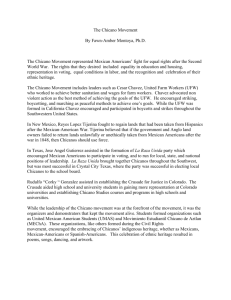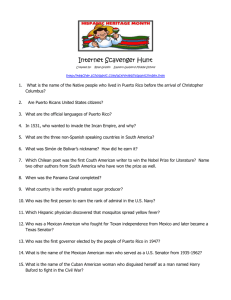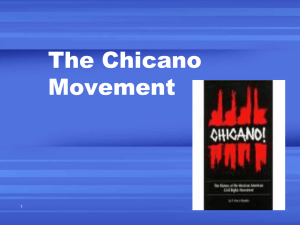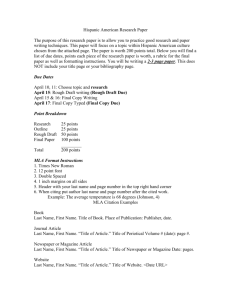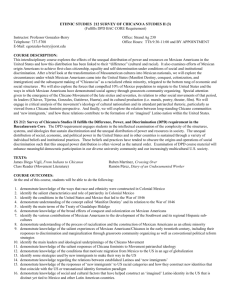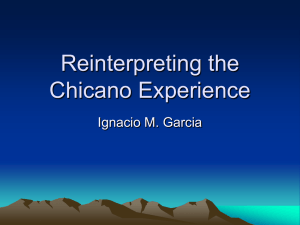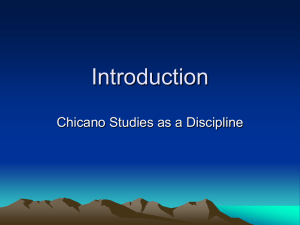Significant Milestones in Chicana/o
advertisement
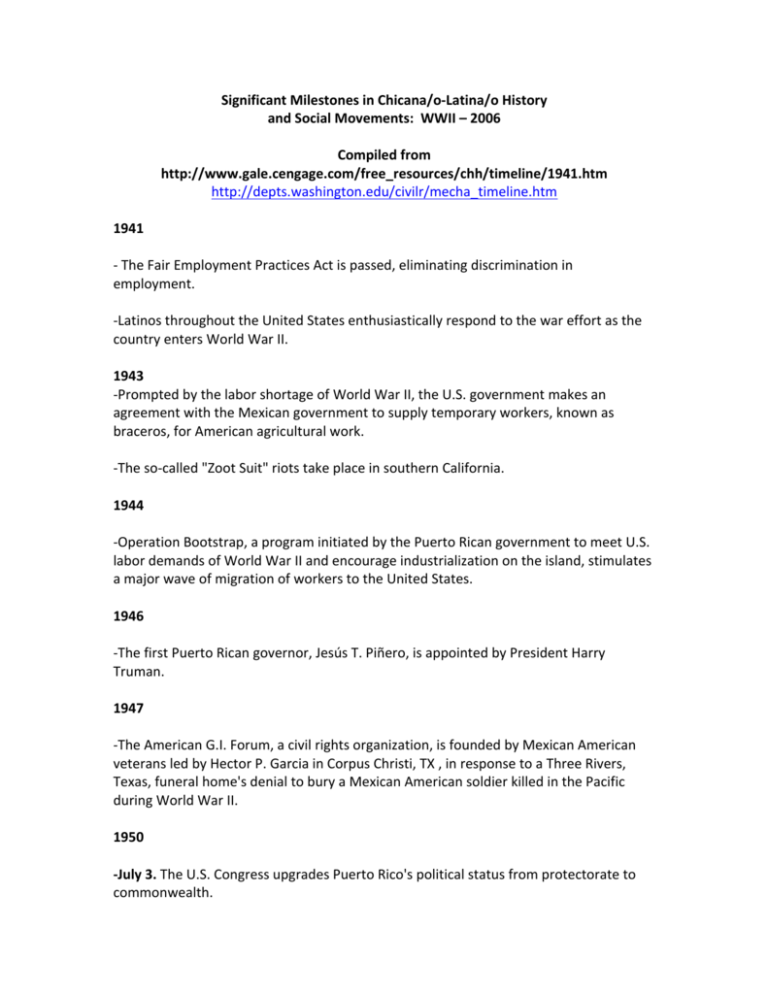
Significant Milestones in Chicana/o-­‐Latina/o History and Social Movements: WWII – 2006 Compiled from http://www.gale.cengage.com/free_resources/chh/timeline/1941.htm http://depts.washington.edu/civilr/mecha_timeline.htm 1941 -­‐ The Fair Employment Practices Act is passed, eliminating discrimination in employment. -­‐Latinos throughout the United States enthusiastically respond to the war effort as the country enters World War II. 1943 -­‐Prompted by the labor shortage of World War II, the U.S. government makes an agreement with the Mexican government to supply temporary workers, known as braceros, for American agricultural work. -­‐The so-­‐called "Zoot Suit" riots take place in southern California. 1944 -­‐Operation Bootstrap, a program initiated by the Puerto Rican government to meet U.S. labor demands of World War II and encourage industrialization on the island, stimulates a major wave of migration of workers to the United States. 1946 -­‐The first Puerto Rican governor, Jesús T. Piñero, is appointed by President Harry Truman. 1947 -­‐The American G.I. Forum, a civil rights organization, is founded by Mexican American veterans led by Hector P. Garcia in Corpus Christi, TX , in response to a Three Rivers, Texas, funeral home's denial to bury a Mexican American soldier killed in the Pacific during World War II. 1950 -­‐July 3. The U.S. Congress upgrades Puerto Rico's political status from protectorate to commonwealth. 1950s -­‐Immigration from Mexico doubles from 5.9 percent to 11.9 percent, and in the 1960s rises to 13.3 percent of the total number of immigrants to the United States. 1950s-­‐1960s -­‐African American workers continue to be the most numerous migrants along the eastern seaboard states, while Mexican and Mexican-­‐American workers soon dominate the migrant paths between Texas and the Great Lakes, the Rocky Mountain region, and the area from California to the Pacific Northwest. 1951 -­‐The Bracero Program is formalized as the Mexican Farm Labor Supply Program and the Mexican Labor Agreement, and will bring an annual average of 350,000 Mexican workers to the United States until its end in 1964. 1954 -­‐In the landmark case of Hernandez v. Texas, the nation's highest court acknowledges that U.S. Latinos are not being treated as "whites." The Supreme Court recognizes Latinos as a separate class of people suffering profound discrimination, paving the way for Hispanic Americans to use legal means to attack all types of discrimination throughout the United States. It is also the first U.S. Supreme Court case to be argued and briefed by Mexican American attorneys. 1959 -­‐The Cuban Revolution succeeds in overthrowing the repressive regime of Batista; Fidel Castro takes power. Cuban Americans immigration to the United States increases sharply after this date. Large-­‐scale Cuban immigration to the United States occurs much more quickly than that from either Puerto Rico or Mexico, with more than one million Cubans entering the country since 1959. -­‐Most of the two million Puerto Ricans who have trekked to the U.S. mainland in this century are World War II or postwar-­‐era entries. Unlike the immigrant experience of Mexicans, or Cubans before 1959, the majority of Puerto Rican immigrants entered the United States with little or no red tape. 1960s -­‐A third phase of labor migration to the United States begins when the established patterns of movement from Mexico and Puerto Rico to the United States are modified, and migration from other countries increases. -­‐The Bracero Program ends in 1964, and, after a brief decline in immigration, workers from Mexico increasingly arrive to work under the auspices of the H-­‐2 Program of the Immigration and Nationality Act of 1952, as well as for family unification purposes, or as undocumented workers. -­‐Young Mexican Americans throughout the United States become caught up in the struggle for civil rights and seek to create a new identity for themselves. These efforts become known as the Chicano Movement. The movement sparks a renaissance in the arts among Mexican Americans. Many Chicano artists call attention to inequalities faced by Mexican Americans, developing new styles of art that eventually gain acceptance in mainstream literary and art scenes 1961 -­‐Aspira (Aspire) is founded in NYC to promote the education of Hispanic youth by raising public and private sector funds. Aspira acquires a national following, serving Puerto Ricans wherever they live in large numbers. 1962 -­‐ December 14 -­‐ United Farm Workers Organizing Committee, led by Cesar Chavez and Dolores Huerta is initiated as an independent organization in Delano, California.. 1963 The Political Association of Spanish-­‐speaking Organizations (PASO) unites to take over the city council for 2 years in Crystal City, Texas. Oct. 8, 1963: La Alianza Federal de los Mercedes is incorporated by Reies Lopez Tijerina in New Mexico. 1964 – January 8 – President Lyndon Johnson declares “War on Poverty” -­‐ Civil Rights Acts were established. -­‐Throughout the early 1960s, segregation is abolished in Texas, Arizona, and other regions, largely through the efforts of the League of United Latin American Citizens (LULAC) and the Alianza Hispano Americana. 1965 – President Johnson delivers commencement; equality in America -­‐ The Voting Rights Act of 1965 is passed, aimed at African American enfranchisement in the South. Obstacles to registration and voting are faced by all minorities, but the act's potential as a tool for Hispanic Americans is not fully realized for nearly a decade. -­‐For the first time, the United States enacts a law placing a cap on immigration from the Western Hemisphere, becoming effective in 1968. – September 1965 – Agricultural Workers Organizing Committee (AWOC) Filipina field hands joined workers Grape Boycott. _ Late Nov.-­‐Dec. 1965: The United Farm Workers Organizing Committee initiates a national table grape boycott. _ The end of the bracero program forces many Mexicans to return to Mexico. They settle near the U.S. border. To provide jobs for them, the Mexican and U.S. governments begin border industrialization programs, allowing foreign corporations to build and operate assembly plants on the border. These plants, known as maquiladoras, multiply rapidly, transforming the border region. The maquiladors attract companies because they provide cheap labor close to American markets. They employ hundreds of thousands of Mexicans in assembly work, but often in poor working conditions. _ A major revision of immigration law results when Congress amends the Immigration and Nationality Act of 1952 (aka Hart-­‐Cellar Immigration Act). The national origin quota system is abolished 1966 – Student activists begin Mexican American Student Organization at St. Mary’s College in San Antonio. – Rodolfo Acuna starts teaching first Mexican American history class in Los Angles, California. -­‐ United Farm workers win a contract with major group growers. -­‐ Rodolfo Gonzalez is fired from the Youth Corps. He founds the Crusade for Justice in Denver, Colorado. -­‐March 17 – April 11, 1966 Cesar Chavez and the National Farm Workers Association march from Delano to Sacramento. -­‐June, 1966 Farm Worker solidarity march from the Rio Grande to Austin, Texas – July 4 – Reies Tijerina plans a march from Albuquerque to Santa Fe. 1967 -­‐ The Mexican American Youth Organization (MAYO) was formed. -­‐ First Chicano Youth conference was held in Denver, Colorado. -­‐ The Mexican American Federation is organized in Yakima, Washington. -­‐ May 13 – 250 students represented 7 Los Angeles colleges to form United Mexican American Students. -­‐ May -­‐ Reies Tijerina is elected the leader of the Chicano contingent on D.C. march – June 5 -­‐ Reies Tijerina conducts an armed raid in Tierra Amarilla on Rio Arriba County Court house. -­‐-­‐ Dec., 1967: David Sanchez takes control of the Young Citizens for Community Action and restructures it into the Young Chicanos for Community Action. The group, which was often harassed by the L.A. County Sheriffs, takes a more militant stance against discrimination and police brutality, evolving into the Brown Berets by early 1968. The Brown Berets would become one of the largest non-­‐student organizations in the country, having chapters as far north as Seattle, Washington, Eugene, Oregon, Denver, Colorado, Detroit, Michigan and Minneapolis, Minnesota. 1968 -­‐Feb. 15 1968: Response to violent repression on Farm Workers lead Cesar Chavez to begin a 25-­‐day fast to keep the farm worker movement. – March 3 – A primarily Chicano school, Abraham Lincoln High School protested school policies and teachers. -­‐March 10-­‐11, 1968: Cesar Chavez breaks his fast at a mass at a park in Delano. -­‐March 1968: On request of the Unites Farm Workers, the American Civil Liberties (ACLU) of Washington goes to the Yakima Valley to help organize a legal assistance program. The report that emerges after the end of the project underlines the societal conditions present that maintained Chicanos in a state of subjugation. -­‐March 27, 1968: A grand jury indicts the L.A. 13 for conspiracy to disrupt the peace in organizing the East L.A. school walkouts. -­‐-­‐ May 27 – Grand jury indicts conspiracy for disrupting peace in school walk out. -­‐ May 29 – The United States Supreme Court protests. -­‐ “Los Amigos” sponsors the migrant labor group. -­‐Nov. 4, 1968: The Unites Mexican American Students (UMAS) and the Clack Student Union(BSU) unite, and Rosalio Munoz is voted in, becoming the first Chicano elected as the University of California at Los Angeles’ Student Body President. 1968: The Mexican American Legal Defense and Education Fund(MALDEF) is organized in San Antonio, TX. It is modeled after the NAACP Legal Defense Fund. 1969 Mar. 27-­‐31 1969: The first National Chicano Youth Liberation Conference is sponsored by Crusade for Justice in Denver, CO. Apr. 1969: A three day conference is organized at Santa Barbara by the Chicano Coordinating Council of Higher Education to create a plan for curricular changes and provide service to Chicano students. The conference also yields the formation of El Movimiento Estudiantil Chicano de Aztlan(MEChA), which the various participating organizations change their name to. -­‐ May 13 – Brown Berets begin “La Casa” Nov. 1969: A young law Student at Loyola University forms Catolicos Por La Raza in California. 1970 -­‐ March, 1970 Raza Freedom School started in Boyle Heights, Los Angeles -­‐ May 13, 1970 Oakland, California – 1000 students walked out of school to protest the war -­‐ Reies Tijerina is arrested for raiding a court house. -­‐ UFW union pickets power company. -­‐July 29, 1970: The National Grape Boycott organized by the UFWOC yields contracts with the most California growers. -­‐ October 7, 1970 Student walk-­‐out in East Chicago, Indiana by more than 600 Chicano students. -­‐ Immigration and Naturalization Service (INS) Commissioner Leonard Chapman claims that there are as many as 12 million undocumented workers in the country. Other observers most commonly place the number in the range of 3.5 million to 5 million people. At this time 82 percent of the Hispanic population of the nation lives in nine states, with the proportion rising to 86 percent in 1990. The largest Hispanic populations are in California, Texas, and New York, and to a lesser degree Florida, Illinois, and New Jersey. -­‐ August 29, 1970: A Chicano Moratorium protest against the Vietnam War organized in Los Angeles. More than 30,000 Chicanos and supporters draw attention to the disproportionately high number of Chicano casualties in that war. Conflicts erupt between police and demonstrators. Journalist Rubén Salazar, not involved in the struggle, is accidentally killed by police. -­‐ The struggle over affirmative action continues when opponents coin the term "reverse discrimination," suggesting that white males are victims of discrimination as a result of affirmative action on behalf of women, blacks, Hispanics, and other under-­‐represented groups. Brutality against Mexican Americans continues. In López v. Harlow, a case filed in an attempt to bring the violence under control, a police officer shoots and kills López, a Mexican American, allegedly in self-­‐defense, because he thought López was about to throw a dish at him. -­‐ The amendments constituting the landmark Voting Rights Act of 1970 add a provision that is designed to guard against inventive new barriers to political participation. It requires federal approval of all changes in voting procedures in certain jurisdictions, primarily southern states. This act prevents minority votes from being diluted in gerrymandered districts or through at-­‐large elections. In 1970, Chicana/o students in Minnesota organized a week-­‐long summer institute to explore the feasibility of establishing a Chicano Studies Department in the Midwest. Participants at the conference came from Wisconsin, Iowa, South Dakota, Nebraska, Illinois, Kansas, Indiana, Michigan, and Ohio. That summer, the 180 conferees, including migrant field workers from Texas, made a unanimous decision that the new unit should study Mexicans in their struggle to settle in the Midwest. In particular, the Latin Liberation Front, led by Ramona Arreguin de Rosales strongly encouraged the creation of a Department of Chicano Studies at the University of Minnesota. 1971 – The FBI’s Counter Intelligence Program infiltrates Chicano Organization. -­‐ Washington State senate passes Chicano commission bill. -­‐ Reies Tijerina is freed from jail. -­‐May 5, 1971: La Marcha de la Reconquista, a march from Calexico to Sacramento, begins with Rosalio Munoz, David Sanchez and the Brown Berets. -­‐ Marcha por Justicia – Albuquerque, New Mexico – 400+ people -­‐ Chicano Moratorium Marcha por Justicia and Rally from all over Southern -­‐ California against police brutality to Belvedere Park, East Los Angeles –10,000 people -­‐ Dissatisfied with the pace of the University response, on October 26, 1971, twenty Chicano students occupied the Twin Cities administration building, Morrill Hall. Within three days of the occupation and ultimatum, College of Liberal Arts committees approved the proposal for a free-­‐standing Chicano Studies Department. 1972 -­‐Ramona Acosta Banuelos becomes the first Hispanic treasurer of the United States. -­‐February 9, 1972: Ramsey Muniz announces bid for Texas governor under the La Raza Unida Party Banner. -­‐March, 1972: Students organize a moratorium to stress the importance of hiring Chicano/a faculty at the UW. -­‐September 1972: La Raza Unida Party holds its national convention. Gutierrez beats Gonzalez for the national chair in campaigns that leads to the division of LRUP into 2 camps. -­‐October 11, 1972: El Centro de La Raza is founded in Seattle by activists and Beacon Hill Community members who occupy an abandoned school. The participants refuse to leave the building until the Seattle School District leases them the space for the creation of a multi-­‐purpose, progressive community organization. -­‐ October 26 – City council committee of Seattle vote to lease school for Chicano center -­‐ The Brown Berets youth organization cited the Treaty of Guadalupe Hidalgos in their take over of the Catalina Island. -­‐ May 2-­‐ University of Washington MEChA members go to reception by the Rainer Brewing Company declaring a boycott on Rainer, for it subsidiaries for labor violations. -­‐ Raza Unida finally recognized as a political party and presented a list of demands. -­‐Chicano Studies accepted its first students in the fall of 1972 and was the first Chicano Studies program in the Upper-­‐Midwest. 1973 -­‐ January 23 – Chicano students occupy a building and present a list of demands about classes specifically for ethnic studies to Yakima Valley College. -­‐ Sep 11, 1973: A CIA-­‐backed coup succeeds in overthrowing the democratically elected Marxist government in Chile. This marks the start of U.S.-­‐backed Gen. Augusto Pinochet's 17 year stint as the head of Chile, which is notoriously known for massive human rights violations. -­‐ An employment discrimination case, Espinoza v. Farah Manufacturing Company, argues discrimination toward an employee, Espinoza, on the basis of his citizenship status under the Civil Rights Act. However, the Supreme Court holds that there is nothing in Title VII, the equal employment opportunities provisions of the Civil Rights Act of 1964, that makes it illegal to discriminate on the basis of citizenship or alienage. -­‐ The Labor Council of Latin American Advancement (LCLAA) forms to promote the interests of Hispanics within organized labor. -­‐ The United Farm Workers Organizing Committee (UFWOC) charters the United Farm Workers (UFW), AFL-­‐CIO 1974 – May 2 – 40 students lead by the University of Washington’s MEChA, demanding more Chicano’s to fill administrative positions, and equal rights for graduating Chicano students. -­‐June 1974: A group of students from Los Angeles and Orange County from El Comite Estudiantil del pueblo. The group, made up primarily of Chicano Marxists, seeks “anti-­‐ imperialism solidarity with national and international student struggles, university reform, self-­‐determination against the imperial system, and student-­‐worker unity. The group later merges with CASA. -­‐ Congress passes the Equal Educational Opportunity Act to create equality in public schools by making bilingual education available to Hispanic youth. According to the framers of the act, equal education means more than equal facilities and equal access to teachers. Students who have trouble with the English language must be given programs to help them learn English. 1975 – The Voting Rights Act of 1965 is extended to “Hispanic Americans” -­‐ Boycott of Grapes was successful and finally was brought to an end. -­‐Vietnam War ends 1977 -­‐José Angel Gutierrez and La Raza Unida Party hold a conference in San Antonio attracting over 2,000activists. -­‐ The Immigration and Naturalization Service (INS) apprehends more than one million undocumented workers each year. -­‐A group of young Cuban exiles called the Antonio Maceo Brigade travels to Cuba to participate in service work and to achieve a degree of rapprochement with the Cuban government. 1978 -­‐The median income of Hispanic families below the poverty level falls from $7,238 in 1978 to $6,557 in 1987, controlling for inflation. 1978-­‐1988 -­‐Hispanic female participation in the work force more than doubles, from 1.7 million to 3.6 million. In 1988, 56.6 percent of Hispanic women are in the work force, compared with 66.2 percent of white women and 63.8 percent of blacks. -­‐The proportion of Hispanic children living in poverty rises more than 45 percent. By 1989, 38 percent of Hispanic children are living in poverty. 1979 -­‐ Political upheaval and civil wars in Nicaragua, El Salvador, and Guatemala contribute to large migrations of refugees to the United States. 1980 -­‐ Japanese industrialists take advantage of the maquiladoras by sending greater amounts of raw materials to Mexico where they are finished and shipped duty-­‐free to the United States. -­‐The rates of immigration approach the levels of the early 1900s: legal immigration during the first decade of the century reached 8.8 million, while during the 1980s, 6.3 million immigrants are granted permanent residence. The immigrants are overwhelmingly young and in search of employment, and Hispanic immigrants continue to account for more than 40 percent of the total. Programs to apprehend undocumented immigrants are implemented, and reports of violations of civil rights are reported. 1980-­‐1988 -­‐The Reagan administration maintains that affirmative action programs entail quotas, constituting a form of reverse discrimination. The number of Hispanics in the work force increases by 48 percent, representing 20 percent of U.S. employment growth -­‐ US. Latin American Policy under the Reagan administration intensifies "low intensity" proxy warfare against leftist movements in Latin America. The civil wars that result from U.S. backing of counter-­‐insurgency militaries lead to an increased migration of Central American political refugees to the United States. 1982 – June 28 – The Supreme Court in favor of Bakke vs. the UC Board of Regents by a vote of 5-­‐4. 1986 -­‐ November 6 – Congress enacts The Immigration Reform and Control Act, making it able for illegal immigrants to become legal by applying for an application who had been in the United States illegally since January 1, 1982. -­‐ After more than a decade of debate, Congress enacts The Immigration Reform and Control Act (IRCA), creating a process through which illegal aliens could become legal immigrants by giving legal status to applicants who had been in the United States illegally since January 1, 1982. 1987 -­‐At this time, 70.1 percent of Hispanic female-­‐headed households with children are living in poverty. 1988 -­‐ President Ronald Reagan appoints the first Hispanic Secretary of Education: Lauro F. Cavazos. 1989 -­‐ Median family income for white families is $35,210; for blacks, $20,210; and for Hispanics, $23,450. Per capita income is $14,060 for whites, $8,750 for blacks, and $8,390 for Hispanics. -­‐Immigration from the Americas rises from 44.3 percent in 1964 to 61.4 percent. Of the major countries, Mexico accounts for 37.1 percent of total documented immigration to the United States, the next highest number of immigrants being from El Salvador, 5.3 percent. 1990 -­‐ President George Bush appoints the first woman and first Hispanic surgeon general of the United States: Antonia C. Novello. 1991 -­‐ The proposed North American Free Trade Agreement between Mexico, the United States, and Canada expands even further the maquiladora concept, offering potentially greater tax abatements for U.S. businesses. -­‐Despite the U.S. Congress' refusal to consider the statehood of Puerto Rico, a referendum is held on the island, clearly showing that the population is in favor of statehood. March. Unemployment among Hispanics in the United States reaches 10.3 percent, roughly double the rate for whites. -­‐October 23. President George Bush signs the Cuban Democracy Act, also known as the Torricelli Bill, which bans trade with Cuba by U.S. subsidiary companies in third countries and prohibits ships docking in U.S. ports if they have visited Cuba. The Torricelli Bill is heavily backed by Cuban Americans, and Bush makes a point of signing it in Miami. Upon passage of the Cuban Democracy Act, the United States is condemned by the United Nations General Assembly for maintaining its 30-­‐year embargo of Cuba; the vote is 59 to 3, with 71 countries abstaining. Even most of the United States' allies either vote to end the embargo or they abstain. 1993 -­‐ President Bill Clinton names Federico Peña to the position of Secretary of Transportation; he is the first Hispanic to hold that post. -­‐President Bill Clinton names Henry Cisneros to the cabinet position of Secretary of Housing and Urban Development (HUD); he is the first Hispanic to hold that post. -­‐President Bill Clinton appoints Norma Cantú, the former director of the Mexican American Legal Defense and Education Fund, to the position of Assistant Secretary for Civil Rights, Department of Education. The president also appoints 25 Hispanics to positions that need confirmation by the Senate. 1994 -­‐ January 1. The North American Free Trade Agreement (NAFTA) takes effect to eliminate all tariffs between trading partners Canada, Mexico, and the United States within fifteen years from this date. Regarding Mexico and the United States, on this date 53.8 percent of U.S. imports from Mexico become duty free, while 31 percent of imports from the United States, excluding those imported by maquiladoras, become duty free. NAFTA passage is opposed in the United States by labor unions, which fear the continuing loss of jobs to Mexico, and domestic industries artificially protected by tariffs, such as textiles. -­‐January 1. In Mexico, as many as one thousand Mayan guerrillas, baptizing themselves the Zapatista National Liberation Army, take over the important southern city of San Cristobal de las Casas, as well as the towns of Ocosingo, Las Margaritas, and others. This leads to bloody confrontations with and repression by the Mexican Army until a cease-­‐ fire is accepted by both sides on January 12, with an agreement to dialogue on the problems of the Mayas in Chiapas. The Mayas of southern Mexico have suffered poverty and dispossession of their communal lands for years. After a cease-­‐fire is established, the government and Mayan rebels sign a tentative 32-­‐point accord on March 2. In the months following the cease-­‐fire, Mayan farmers seize some 75,000 acres of ranch lands, claiming that the lands had been stolen from them as far back as 1819 Thus, the issue of land remains on the table in the continuing negotiations with the Mayas. -­‐November 8. Californians pass Proposition 187 with 59 percent of the vote. The initiative bans undocumented immigrants from receiving public education and public benefits such as welfare and subsidized health care, except in emergency circumstances; makes it a felony to manufacture, distribute, sell, or use false citizenship or residence documents; and requires teachers, doctors, and other city, county, and state officials to report suspected and apparent illegal aliens to the California attorney general and the Immigration and Naturalization Service (INS). Governor Pete Wilson issues an executive order for state officials to begin following the initiative by cutting off government services to undocumented pregnant women and nursing home patients. On November 9, 1994, eight lawsuits are filed in state and federal courts protesting the measure. -­‐November 16. In Los Angeles, California, Federal District Court Judge William Matthew Byrne, Jr., temporarily blocks the enforcement of Proposition 187, stating that it raises serious constitutional questions. Judge Byrne exempts the provisions that increase penalties for manufacturing or using false immigration documents. 1995 -­‐ A nationwide boycott of ABC-­‐TV by Hispanic Americans is held in Los Angeles, New York, Chicago, Houston, San Francisco, and Fresno, in protest of the network's failure to provide Latino themed programming in its 1994 line-­‐up. -­‐Federal Judge Mariana Pfaelzer rules that Proposition 187 is unconstitutional. -­‐February 21. President Bill Clinton is successful in arranging for an international loan-­‐ guarantee package of $53 billion, with $20 million from the United States, to prop up the devalued peso and restore confidence in the Mexican economy, which is in a state of crisis. 1996 -­‐ Proposition 209, introduced as a ballot initiative, is passed by the California voters. The initiative bars preferential treatment based on race or gender, virtually eliminating affirmative action in state hiring, public contracts, and education. Although challenged in court, the U.S. Supreme Court refused to hear the appeal, and Proposition 209 eventually takes effect in California. 1998 -­‐On June 2, California voters pass Proposition 227, which bans bilingual classroom education and English as a second language programs, replacing them with a one-­‐year intensive English immersion program. A federal judge denies challenges to the proposition in July, and 227 goes into effect in California schools in August. -­‐The U.S. Census Bureau reports a decline in the number of black and Hispanic Americans living in poverty. -­‐African Americans and Hispanic Americans represent 16 percent of voters in the United States, compared to 1994, when the two groups made up 12 percent of U.S. voters 1999 -­‐ Hispanic groups join the National Association for the Advancement of Colored People (NAACP) in protesting the lack of minority roles in prime-­‐time shows in the fall line-­‐up. -­‐ September. New York Hispanic leaders criticize Hilary Rodham Clinton, probable Democrat candidate for U.S. Senate. Clinton had proposed that her husband, President Bill Clinton, should withdraw his clemency offer for 16 imprisoned members of the Puerto Rican Armed Forces of National Liberation (FALN), which was linked to more than 100 U.S. bombings. U.S. Representative José Serrano states that he withdraws his support for her, voicing the common complaint that Mrs. Clinton did not consult with the Puerto Rican leaders or try to understand the situation before making her statement. Many leaders express the sentiment that the Hispanic community is too significant a vote in New York to be ignored. 2000 California makes César Chávez Day a full, paid holiday for state employees. Texas currently has the holiday on a "volunteer" status and Arizona is working on adding the holiday in the upcoming elections. -­‐Thousands protest the Vieques Agreement. Puerto Ricans are fighting to stop the U.S. Navy from resuming bombing exercises on the island of Vieques. The Puerto Rican government recently agreed to let the U.S. resume training exercises after a civilian security guard was killed in an accidental bombing in April. -­‐Hispanic Web presence grows. Several Spanish-­‐language Web sites are been launched in 1999 and 2000, including Spanish versions of AOL and Yahoo!. The Spanish company Terra Networks also signed a deal with Lycos to target Hispanic Americans on the Web, while Yupi.com, another Spanish-­‐language portal, has been making plans to offer stock to the public. To further boost the Hispanic presence on the Internet, Gateway invested $10 million in quepasa.com and Microsoft announced the creation of a new Spanish-­‐ language Web portal in Mexico. Spanish-­‐language Web sites are expected to grow exponentially over the next few years. 2001 -­‐Rosario Marin is sworn in as the 41st treasurer of the United States, becoming the first Mexican-­‐born citizen to head the Treasury and the highest-­‐ranking Hispanic woman in the Bush Administration. Cari Dominguez is appointed chair of the Equal Employment Opportunity Commission (EEOC), the nation’s foremost civil rights agency 2003 -­‐ Hispanics are pronounced the nation's largest minority group — surpassing African Americans — after new Census figures are released showing the U.S. Hispanic population at 37.1 million as of July 2001. 2005 -­‐December. The U.S. House of Representatives passes a bill (H.R. 4437) intended to strengthen enforcement of immigration laws and enhance border security. The law would impose criminal penalties on aliens who illegally enter the United States, require employers to verify employment eligibility, and authorize the construction of fences along the U.S.-­‐Mexico border. Opponents fear that the legislation will result in unfair treatment of immigrants, particularly in communities along the Mexican border, and create new roadblocks to gaining citizenship. The bill is sent to the Senate. 2006 -­‐ According to the Census Bureau, the number of Hispanic-­‐owned businesses grew three times faster than the national average for all U.S. businesses. -­‐Thousands of people join rallies in cities across the country to protest proposed immigration reform. The protests, organized by labor, civil rights, community, labor and religious interests, culminate on April 10 in a “National Day of Action.”
